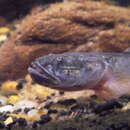Brief Summary
provided by EOL authors
The gobioid genus Gobioides Lacepede, 1800 shares with the amblyopine gobies (Gobiidae: Ambtyopinae) an eel-like, elongate body with a continuous dorsal fin and an affinity for shallow water, muddy bottom habitats. Due to similarities in external morphology and habitat requirements, some workers considered Gobioides allied with amblyopine gobies. Others, however, dispute a close relationship between Gobioides and the Amblyopinae. Gobioides is easily distinguished from the Amblyopinae by its larger eyes (small in Gobioides vs. inconspicuous in the Amblyopinae), fewer dorsal and anal-fin rays (14-20 vs. 27-48), and different fin element to vertebra ratios (1:1 vs. 2:1). Gobioides reaches lengths of 500mm SL or greater whereas ambtyopines rarely exceed 300mm SL. Gobioides comprises five species (G. africanus, G. broussoneti, G. grahamae, G. peruanus, and G. sagitta). Although these gobies occupy habitats with similar conditions, Gobioides and amblyopines are nowhere sympatric. Gobioides occurs in tropical and subtropical coastal waters of the eastern and western Atlantic as well as the tropical eastern Pacific Ocean. In the eastern Atlantic, Gobioides is known from Senegal to Zaire. In the western Atlantic, Gobioides is reported from South Carolina to southern Brazil. In the eastern Pacific, Gobiodes is known from Mexico to Peru.
Diagnostic Description
provided by EOL authors
Body greatly elongate with a continuous dorsal fin. Only genus of gobioid fishes that possesses a spinous dorsal-fin pterygiophore formula of 3-12201.
Comprehensive Description
provided by EOL authors
Elongate, body depth 9-14% SL; head length 15-21% SL; head width 5-8% SL; continuous dorsal fin, VI-I, 14-15 or 19; spines flexible; dorsal-fin base long, broadly joined with base of caudal fin (except in G. africanus where dorsal fin not connected to caudal fin). Precaudal vertebrae 10, caudal vertebrae 16-17, or 21. Anal fin I, 13-15, or I, 19, segmented rays branched; anal-fin spine much reduced; height of anal fin moderate, less than height of dorsal fin: anal-fin membrane broadly joined to base of caudal fin (except in G. africanus where anal fin not connected to caudal fin). Two anal-fin pterygiophores anterior to first hemal spine. Pectoral fin with 15-20 rays; rounded and tapered posteriorly, terminating at point anterior to vertical from posteriormost margin of pelvic fin. Pelvic fin 1, 5; frenum present: basal membrane uniting fins present; broadly rounded posteriorly. Caudal fin with t7 segmented rays; procurrent rays 6 dorsally, 5-6 ventrally.
Gobioides: Brief Summary
provided by wikipedia EN
Gobioides is a genus of gobies native to marine, fresh and brackish waters along the coasts of the Atlantic Ocean and in fresh waters of the Pacific coast of the Americas.
- license
- cc-by-sa-3.0
- copyright
- Wikipedia authors and editors

